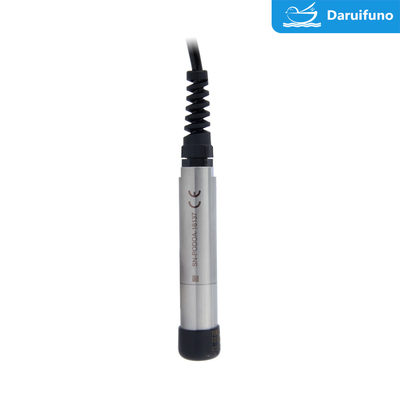Low power consumption fluorescence digital RS485/SDI12 communication dissolved oxygen sensor
The online dissolved oxygen sensor with low power consumption fluorescence method is a sensor that uses the principle of fluorescence method to measure dissolved oxygen, which has the advantages of low energy consumption and long-term monitoring.
Low power consumption light source, sensitive layer and fluorescent material selection, low power consumption electronic circuit design, low power consumption microcontroller and communication module, energy saving mode and sleep mode, low power consumption fluorescence method online dissolved oxygen sensor can achieve long-term stable dissolution Oxygen monitoring and high efficiency in terms of energy consumption. It is suitable for applications requiring long-term and continuous monitoring of dissolved oxygen, such as environmental monitoring, water quality monitoring, water treatment and other fields.
Advantages of The Optical Dissolved Oxygen Sensor
- A low power consumption dissolved oxygen sensor
- ASTM International Method D888-05 and Standard ISO 17289
- Based on digital and lightweight designed sensor
- Can be easily connected with online transmitters, DTU
- RS485 Modbus protocol, support access to industrial control system
- Protection grade IP68, can work continuously under water for a long time
- Internal storage of calibration data, support offline calibration, plug and play
Technical Characteristics
| Model |
OPTOD-S |
OPTOD-T |
OPTOD-P |
| Measuring Technology |
Luminescence optical measurement |
| Measuring Range |
Saturation: 0~200%
Dissolved oxygen: 0.00~20.00mg/L 0.00~20.00ppm
Temp: 0~50℃
|
| Resolution |
Dissolved oxygen: 0.01mg/L Saturation: 1% Temp: 0.1℃ |
| Accuracy |
Dissolved oxygen: ±0.1mg/L Saturation: ±1% Temp: ±0.1℃ |
| Response Time |
0~100% T90<40s, 100~0% T90<65s |
| Water Move |
No necessary move |
| Frequency of Measure |
>5s |
| Digital Output |
RS485, Modbus RTU and SDI-12 |
| Related Compensation |
Temp/salinity/pressure compensation |
| Calibration |
Zero and span calibration |
| Work Pressure |
0~5Bar |
| Work Temperature |
0~50℃ |
| Storage Temp |
-10~60℃ |
| Material |
316L SS |
Ti |
POM |
| Power Supply |
DC 5~12V |
| Dimensions |
Diameter: 25mm Length: 150mm |
Diameter 27mm, length 150mm
Add protection head: length 170mm
|
| Lead interface |
Integral |
| Connection |
Default barewires (9 armoured connectors, polyurethane jacket, waterproof Fisher connector need to be customized) |
| Protection Grade |
IP68 |
| Installation Information |
Immersed or piped installation (Requires mounting accessory support) |
| Cable |
Standard 7 meters (other length can be customized) |
| Consumption |
Standby : 25 µA
Average RS485 (1 measure/seconde) : 4.4 µA
Average SDI12 (1 measure/seconde) : 7.3 mA
Current pulse : 500 mA Heating time : 100 mA
|
| Application |
Surface water, sewage, industrial effluent, urban wastewater |
Please click the pH sensor user manual here:
OPTOD Sensor user manual.pdf
Application Of The Optical Dissolved Oxygen Sensor
Urban wastewater treatment
Industrial effluent treatment
Surface water monitoring
Seawater
Fish farming
Aquarium
Drinking water

Common dissolved oxygen detection methods and their characteristics:
1. Fluorescence sensor:
Advantages: high sensitivity, wide measurement range, high accuracy, real-time monitoring, no sample processing, long life and stability.
Disadvantages: special sensor equipment is required, and the cost is high.
2. Electrochemical sensor (polarography or electrode method):
Advantages: high sensitivity, real-time monitoring, no need for sample processing, and on-site measurement.
Cons: Susceptible to interfering substances, requires regular calibration and maintenance.
3. Oxygen concentration measuring instrument:
Advantages: easy to use, real-time monitoring, no sample processing required.
Disadvantages: narrow measurement range and low accuracy.
4. Needle dissolved oxygen electrode:
Advantages: real-time monitoring, no sample processing, and can be used in the field.
Cons: Sensitive to temperature changes, requires regular calibration and maintenance.
5. Dissolved oxygen measurement method in the bottle (wen bottle method):
Advantages: relatively simple, suitable for laboratory conditions.
Disadvantages: Not suitable for real-time monitoring, requires sample sampling, susceptible to external interference.

 Your message must be between 20-3,000 characters!
Your message must be between 20-3,000 characters! Please check your E-mail!
Please check your E-mail!  Your message must be between 20-3,000 characters!
Your message must be between 20-3,000 characters! Please check your E-mail!
Please check your E-mail! 









